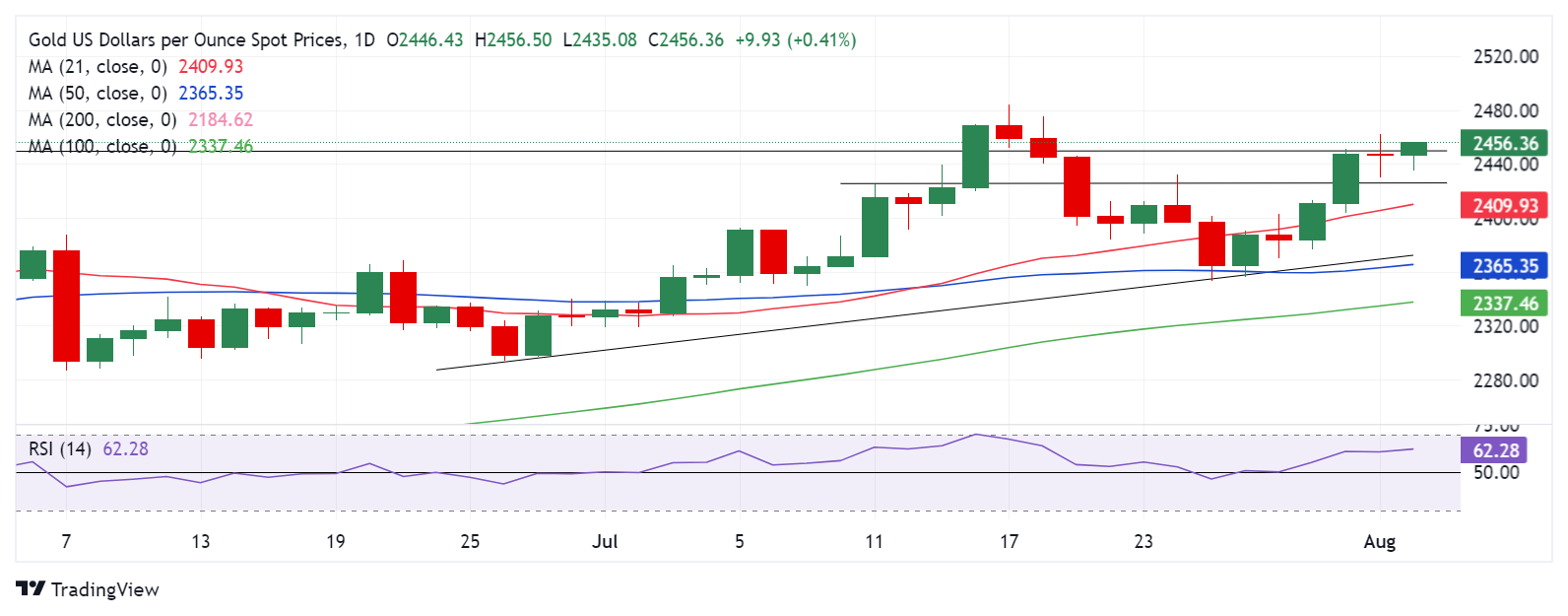Gold Price Forecast: XAU/USD eyes a sustained move above $2,450 and US Nonfarm Payrolls
Premium|
You have reached your limit of 5 free articles for this month.
Get all exclusive analysis, access our analysis and get Gold and signals alerts
Elevate your trading Journey.
UPGRADE- Gold price is looking to regain footing early Friday amid intense risk aversion.
- Dovish Fed bets keep the US Dollar and US Treasury bond yields on the back foot.
- Middle East escalation and US economic woes keep Gold buyers hopeful.
- Gold price looks poised to extend recent upside but US Nonfarm Payrolls report holds the key.
Gold price is gathering pace to resume the recent upside early Friday, following a flattish close on Thursday. Gold price needs to find acceptance above the $2,450 barrier but its next price direction depends upon the US Nonfarm Payrolls data release.
US Nonfarm Payrolls and Middle East tension in focus
Gold price witnessed a lackluster performance on Thursday, as markets assessed the implications of the dovish US Federal Reserve (Fed) policy outlook and the escalating Middle East geopolitical tensions between Iran and Israel.
Even though odds for a 50 basis points (bps) Fed rate cut in September rose, and there was widespread risk aversion, Gold price failed to capitalize, as investors rushed to safety in the US Dollar (USD) instead.
Risk-off flows remained in vogue, courtesy of the heightening Middle East tensions. New York Times reported that Iranian Supreme Leader Ali Khamenei has ordered a direct strike on Israel for the killing of Hamas chief Haniyeh. Meanwhile, Israel confirmed on Thursday the killing of Hamas military chief Mohammed Deif after days of suspense.
Later in American trading, risk aversion intensified after the US ISM Manufacturing PMI showed further contraction and raised worries over the health of the US economy. The flight to safety mode spiked up the demand for the Greenback and the US government bonds, weighing heavily on the US Treasury bond yields, with the benchmark 10-year rates giving up the 4.0% key level.
US ISM Manufacturing PMI declined from 48.5 to 46.8 in July, falling below the expected 48.8. New orders dropped from 49.3 to 47.4. Downbeat US data ramped up bets for a 50 bps September Fed rate cut to 31%, compared to 12% seen a day before. Dovish Fed expectations offset the broad US Dollar comeback, cushioning the downside in Gold price.
Early Friday, Gold price is finding fresh demand from a pause in the US Dollar upsurge, as traders refrain from placing fresh bets on the buck in the lead-up to the all-important US labor market data. The US NFP report holds more significance this time around, especially after the US central bank tweaked its policy statement on Wednesday to say that it is "attentive to the risks to both sides of its dual mandate", rather than previously only noting its attention to inflation risks.
The US economy is likely to have added 175K jobs in July after registering a 206K job gain in June. The Unemployment Rate is seen steadying at 4.1% while the annual Average Hourly Earnings are set to rise by 3.7% in July, following June’s 3.9% increase.
Gold price technical analysis: Daily chart
Weak headline NFP print combined with soft wage inflation could bolster 50 bps rate-cut bets for September by the Fed, triggering a fresh Gold price rally.
In such a case, Gold price could retest the July 18 high of $2,475, above which the lifetime highs of $2,484 will be in focus.
Gold buyers, however, need to find a daily candlestick close above the previous record high of $2,450 for a sustained uptrend.
The 14-day Relative Strength Index (RSI) is gradually edging higher while above the 50 level, currently near 61.75, suggesting that upside risks remain intact for Gold price.
Conversely, Gold price could fall sharply to the previous resistance-turned support at $2,425 should the employment data outpace market expectations and pour cold water on big Fed rate cuts.
The next downside target is aligned at the 21-day Simple Moving Average (SMA) at $2,410. Additional declines could challenge the confluence support near $2,370, where July 29 lows meet with the 50-day SMa and the 100-day SMA.
Economic Indicator
Nonfarm Payrolls
The Nonfarm Payrolls release presents the number of new jobs created in the US during the previous month in all non-agricultural businesses; it is released by the US Bureau of Labor Statistics (BLS). The monthly changes in payrolls can be extremely volatile. The number is also subject to strong reviews, which can also trigger volatility in the Forex board. Generally speaking, a high reading is seen as bullish for the US Dollar (USD), while a low reading is seen as bearish, although previous months' reviews and the Unemployment Rate are as relevant as the headline figure. The market's reaction, therefore, depends on how the market assesses all the data contained in the BLS report as a whole.
Read more.Next release: Fri Aug 02, 2024 12:30
Frequency: Monthly
Consensus: 175K
Previous: 206K
Source: US Bureau of Labor Statistics
America’s monthly jobs report is considered the most important economic indicator for forex traders. Released on the first Friday following the reported month, the change in the number of positions is closely correlated with the overall performance of the economy and is monitored by policymakers. Full employment is one of the Federal Reserve’s mandates and it considers developments in the labor market when setting its policies, thus impacting currencies. Despite several leading indicators shaping estimates, Nonfarm Payrolls tend to surprise markets and trigger substantial volatility. Actual figures beating the consensus tend to be USD bullish.
- Gold price is looking to regain footing early Friday amid intense risk aversion.
- Dovish Fed bets keep the US Dollar and US Treasury bond yields on the back foot.
- Middle East escalation and US economic woes keep Gold buyers hopeful.
- Gold price looks poised to extend recent upside but US Nonfarm Payrolls report holds the key.
Gold price is gathering pace to resume the recent upside early Friday, following a flattish close on Thursday. Gold price needs to find acceptance above the $2,450 barrier but its next price direction depends upon the US Nonfarm Payrolls data release.
US Nonfarm Payrolls and Middle East tension in focus
Gold price witnessed a lackluster performance on Thursday, as markets assessed the implications of the dovish US Federal Reserve (Fed) policy outlook and the escalating Middle East geopolitical tensions between Iran and Israel.
Even though odds for a 50 basis points (bps) Fed rate cut in September rose, and there was widespread risk aversion, Gold price failed to capitalize, as investors rushed to safety in the US Dollar (USD) instead.
Risk-off flows remained in vogue, courtesy of the heightening Middle East tensions. New York Times reported that Iranian Supreme Leader Ali Khamenei has ordered a direct strike on Israel for the killing of Hamas chief Haniyeh. Meanwhile, Israel confirmed on Thursday the killing of Hamas military chief Mohammed Deif after days of suspense.
Later in American trading, risk aversion intensified after the US ISM Manufacturing PMI showed further contraction and raised worries over the health of the US economy. The flight to safety mode spiked up the demand for the Greenback and the US government bonds, weighing heavily on the US Treasury bond yields, with the benchmark 10-year rates giving up the 4.0% key level.
US ISM Manufacturing PMI declined from 48.5 to 46.8 in July, falling below the expected 48.8. New orders dropped from 49.3 to 47.4. Downbeat US data ramped up bets for a 50 bps September Fed rate cut to 31%, compared to 12% seen a day before. Dovish Fed expectations offset the broad US Dollar comeback, cushioning the downside in Gold price.
Early Friday, Gold price is finding fresh demand from a pause in the US Dollar upsurge, as traders refrain from placing fresh bets on the buck in the lead-up to the all-important US labor market data. The US NFP report holds more significance this time around, especially after the US central bank tweaked its policy statement on Wednesday to say that it is "attentive to the risks to both sides of its dual mandate", rather than previously only noting its attention to inflation risks.
The US economy is likely to have added 175K jobs in July after registering a 206K job gain in June. The Unemployment Rate is seen steadying at 4.1% while the annual Average Hourly Earnings are set to rise by 3.7% in July, following June’s 3.9% increase.
Gold price technical analysis: Daily chart
Weak headline NFP print combined with soft wage inflation could bolster 50 bps rate-cut bets for September by the Fed, triggering a fresh Gold price rally.
In such a case, Gold price could retest the July 18 high of $2,475, above which the lifetime highs of $2,484 will be in focus.
Gold buyers, however, need to find a daily candlestick close above the previous record high of $2,450 for a sustained uptrend.
The 14-day Relative Strength Index (RSI) is gradually edging higher while above the 50 level, currently near 61.75, suggesting that upside risks remain intact for Gold price.
Conversely, Gold price could fall sharply to the previous resistance-turned support at $2,425 should the employment data outpace market expectations and pour cold water on big Fed rate cuts.
The next downside target is aligned at the 21-day Simple Moving Average (SMA) at $2,410. Additional declines could challenge the confluence support near $2,370, where July 29 lows meet with the 50-day SMa and the 100-day SMA.
Economic Indicator
Nonfarm Payrolls
The Nonfarm Payrolls release presents the number of new jobs created in the US during the previous month in all non-agricultural businesses; it is released by the US Bureau of Labor Statistics (BLS). The monthly changes in payrolls can be extremely volatile. The number is also subject to strong reviews, which can also trigger volatility in the Forex board. Generally speaking, a high reading is seen as bullish for the US Dollar (USD), while a low reading is seen as bearish, although previous months' reviews and the Unemployment Rate are as relevant as the headline figure. The market's reaction, therefore, depends on how the market assesses all the data contained in the BLS report as a whole.
Read more.Next release: Fri Aug 02, 2024 12:30
Frequency: Monthly
Consensus: 175K
Previous: 206K
Source: US Bureau of Labor Statistics
America’s monthly jobs report is considered the most important economic indicator for forex traders. Released on the first Friday following the reported month, the change in the number of positions is closely correlated with the overall performance of the economy and is monitored by policymakers. Full employment is one of the Federal Reserve’s mandates and it considers developments in the labor market when setting its policies, thus impacting currencies. Despite several leading indicators shaping estimates, Nonfarm Payrolls tend to surprise markets and trigger substantial volatility. Actual figures beating the consensus tend to be USD bullish.
Information on these pages contains forward-looking statements that involve risks and uncertainties. Markets and instruments profiled on this page are for informational purposes only and should not in any way come across as a recommendation to buy or sell in these assets. You should do your own thorough research before making any investment decisions. FXStreet does not in any way guarantee that this information is free from mistakes, errors, or material misstatements. It also does not guarantee that this information is of a timely nature. Investing in Open Markets involves a great deal of risk, including the loss of all or a portion of your investment, as well as emotional distress. All risks, losses and costs associated with investing, including total loss of principal, are your responsibility. The views and opinions expressed in this article are those of the authors and do not necessarily reflect the official policy or position of FXStreet nor its advertisers.
